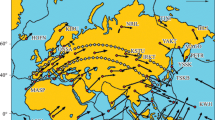Abstract
A two-dimensional thermo-mechanical finite element model is used to study the Permo-Carboniferous evolution of Central Europe along a lithosphere-scale transect from the Variscan Internides to the undeformed foreland. The study concentrates on a quantitative evaluation of the processes controlling late-orogenic extension and destruction of the Variscides, particularly the gravitational instability of thickened crust. Modelling results suggest that gravitational forces along cannot reproduce the observed timing and amount of Permo-Carboniferous crustal thinning. Tensile plate-boundary forces are required in addition to gravitation to restore a crustal thickness of approximately 30 km in the Variscan Internides. Stresses as little as 10 MPa result in up to 28% extension and a good fit between observed data and model predictions. It is concluded that the Stephanian to Rotliegend evolution in the vicinity of the modelled traverse resulted not from gravitational forces inherited from Variscan crustal thickening, but was related to a change in orientation of the plate-boundary stresses at the end of the Westphalian.
Similar content being viewed by others
Author information
Authors and Affiliations
Additional information
Received: 2 November 1995 / Accepted: 30 September 1996
Rights and permissions
About this article
Cite this article
Henk, A. Gravitational orogenic collapse vs plate-boundary stresses: a numerical modelling approach to the Permo-Carboniferous evolution of Central Europe. Geol Rundsch 86, 39–55 (1997). https://doi.org/10.1007/s005310050120
Issue Date:
DOI: https://doi.org/10.1007/s005310050120




